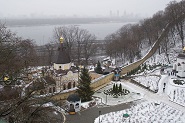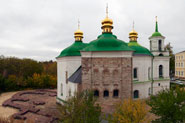Kiev Pechersk Lavra of Saint Assumption
“Like a fairytale created by somebody great and wise, it stands over the river.
The water of Dnieper runs and splashes joyfully while seeing it from afar”.
 Kiev Pechersk Lavra is a monastery of caves, founded in the middle of 11th century. It became one of the centers of Christianity extension in Eastern Europe and Kiev Rus. Being monks of the monastery, its founders put all their soul and imagination in creation of this world famous architectural complex.
Kiev Pechersk Lavra is a monastery of caves, founded in the middle of 11th century. It became one of the centers of Christianity extension in Eastern Europe and Kiev Rus. Being monks of the monastery, its founders put all their soul and imagination in creation of this world famous architectural complex.
Today Kiev Pechersk Lavra is composed of three different areas: the Upper Lavra, constructions on Near caves and Far caves.
There, on Kiev hills blessed by Lord, the Kiev Pechersk historical reserve and Saint Assumption monastery are neighbors. The second one was revivified in 1988 after a long period of “militant atheism” in ex-Soviet Union.
In 12th century the title of “Lavra” was given to the monastery, which stands for an orthodox monastery of the highest rang. In 18th it was one of the greatest and richest monasteries in Russian Empire. The architectural composition created in that period of time is mostly that we can see today.
A special attention should be drawn to some buildings on Lavra’s territory, which was founded in times of princes – Saint Trinity Church over Gates, Church of Our Saviour in Berestovo, where founder of Moscow Yurii Dolgorukii was buried.
The name of the monastery “Pecherskii” comes from word “Pechery” that means “caves”. First monks settled there in caves, as the chronicle “Story of the bygone years” tells. Later above-ground constructions appeared on the territory of monastery. The caves become the place where monks were buried.
In 1240 the monastery was harried by nomads. In second half of 14th century it is under the power of Lithuanian Principality, then under Poland. In 1615 first printery is founded in Lavra, where worked in groups eminent public figures and scientists.
In 1926 monastery was closed. The architectural composition suffered heavily in 1941, when the main temple – The Assumption Cathedral – was blown up and destroyed. In 1988 Lavra was sanctified anew. Now it is one of the orthodox religious centers in Ukraine with its own seminary, academy, residence of Patriarch, and a complex of more than 100 buildings. These are: revivified Cathedral of the Assumption, Holy Trinity Church over gates, All Saints church, monastic cells, bell tower, fortification edifices and so on.
A special interest present monastery caves, named Near and Far caves, separated by a ravine and a hill range. In caves rest the holy imperishable relics of monks, which are believed to be beneficial. Caves are from 5 to 15 meters of deep and there are underground temples, burial hovels, anchorages of monks-recluses.
On the territory of Kiev Pechersk Lavra museums and expositions are open. Among them are: museum of books and printery, museum of historical treasures, museum of Ukrainian art and others. One of the most popular is an exposition of micro miniatures, created by Nikolai Syadristii. He is an author of exponents that can be seen only with a help of microscope – a dragonfly with watches that keep perfect time instead of eyes, shod flea etc.
An architectural ensemble of Kiev Pechersk Lavra presents a unique importance and value. All monuments are located on a picturesque ground. High and low structures form a contrast. Slender bell towers are well combined with silhouettes of temples, snow-white walls of monks’ cells and other buildings that look like to be hidden in green. All these traits make Lavra’s complex an original and scenic beauty one.
By the decision of UNESCO Kiev Pechersk Lavra is a monument of a worldwide heritage.

